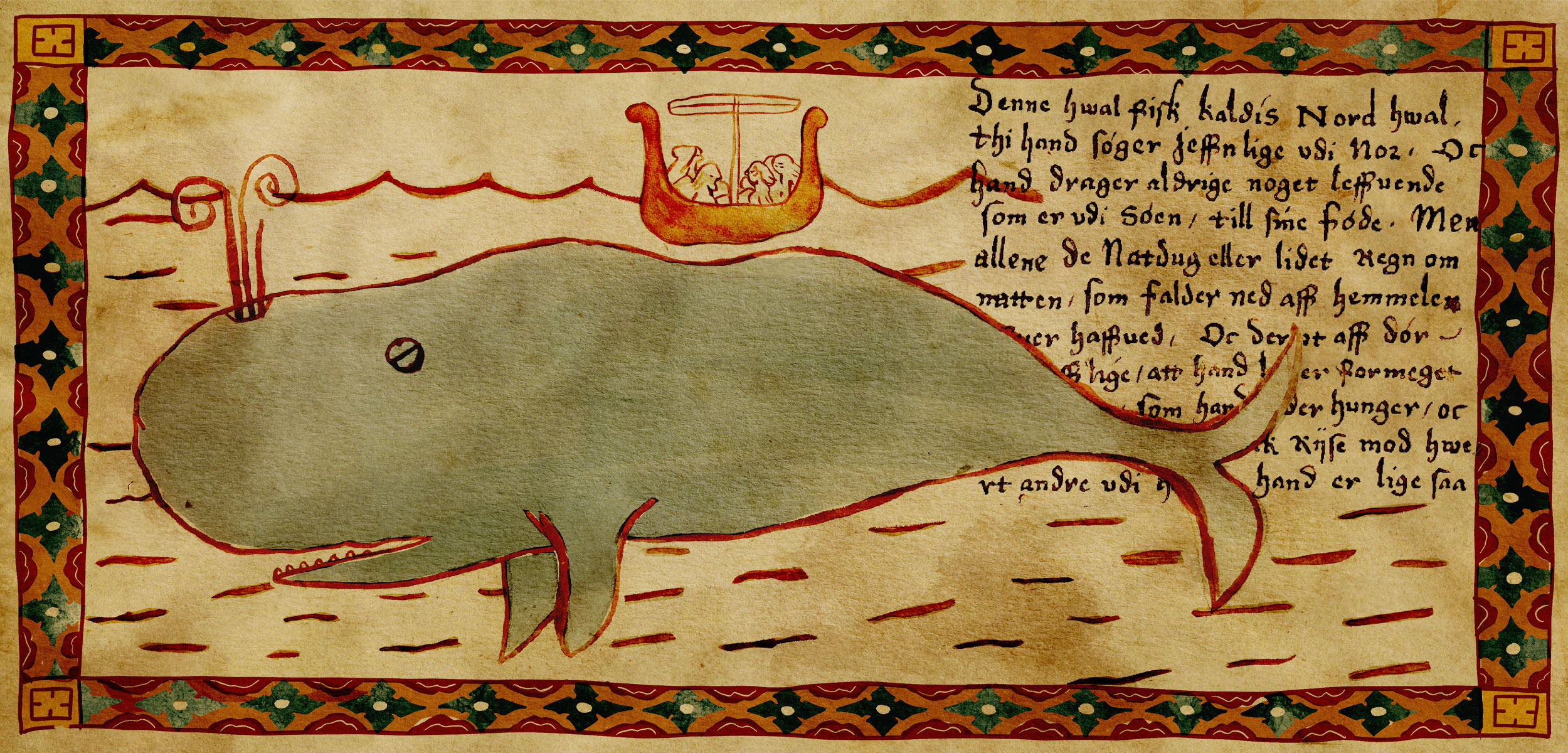How Viking-Age Hunters Took Down the Biggest Animal on Earth
New research suggests that medieval Icelanders were scavenging and likely even hunting blue whales long before industrial whaling technology.
Article body copy
In the fall of 1385, according to a 17th-century Icelandic text, a man named Ólafur went fishing off the northwestern coast of Iceland. In the cold seas cradled by the region’s labyrinthine fjords, Ólafur reportedly came across an animal that would have dwarfed his open wooden boat—a blue whale, the largest animal on record, known in the Icelandic language as steypireyður.
Jón Guðmundsson, or Jón the Learned, the poet and scholar who recorded Ólafur’s story, called blue whales the “best and holiest of all whales.” For sailors who were in danger from other, more “evil” whales, Guðmundsson wrote, “it is good to seek shelter with the blue whale, if it is close at hand, and to stay as close to it as possible.” He went on to explain that blue whales were typically calm animals whose size alone intimidated more dangerous sea creatures.
Blue whales weren’t just mythic protectors of medieval Icelanders, though—increasing evidence suggests that they were also an important food source. When the massive whale surfaced next to Ólafur’s boat, the man thrust his homemade spear into the flesh of the whale. The spear would have been marked with Ólafur’s signature emblem, and if all went well, Ólafur would wound the whale badly enough that it would wash up dead on a nearby shore. Whoever found it would know Ólafur had dealt the deadly blow by the markings on the spear tip, and he could stake his claim on the whale’s bounty. In an era when most Icelanders survived predominantly by raising sheep, a blue whale—which can reach more than 30 meters long and weigh as much as 150 tonnes—was a caloric windfall. One animal could yield 60 tonnes of meat—the equivalent of 3,000 lambs—and, according to a 13th-century Norse text, was reportedly “better for eating and smells better than any of the other fishes.”
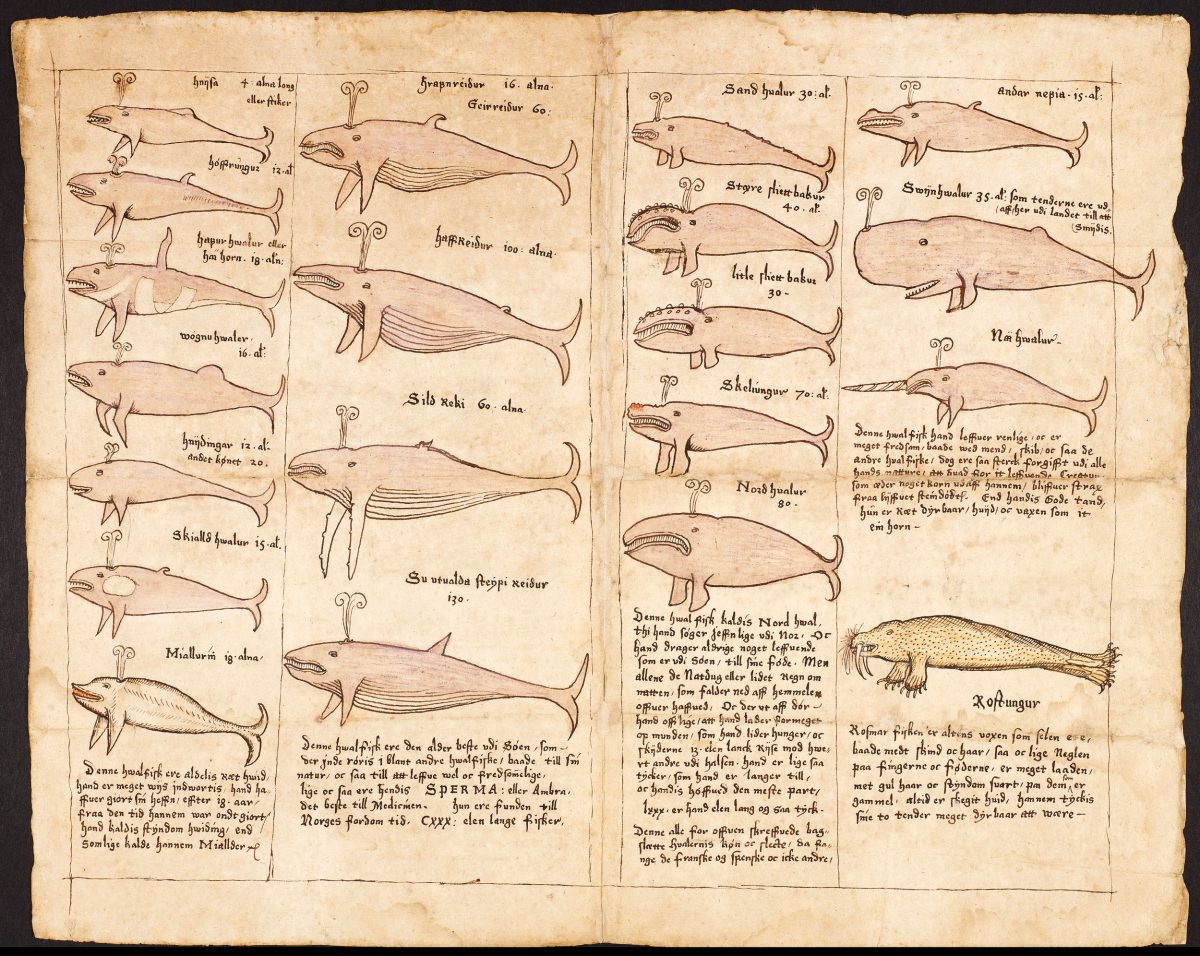
A drawing of 19 whales and a walrus by Jon Guðmundsson, a 17th-century poet and scholar. Photo courtesy of the Royal Danish Library
Yet, Ólafur wasn’t so lucky. The whale’s body never turned up on Iceland’s shores. Later, though, a group of hungry travelers some 1,500 kilometers away, in Greenland, came across a recently dead, beached blue whale. The party was led by an Icelandic chieftain, and Guðmundsson recounts that as he and his men butchered the animal, they found embedded within it an iron spearhead marked with Ólafur’s emblem. Knowing they couldn’t deliver Ólafur his bounty, the men ate the whale, staving off starvation.
This story—one of many similar tales that environmental historian Vicki Szabo has been scouring over the last three decades—offers a compelling glimpse into Icelanders’ interactions with blue whales. Norse texts can be scientifically accurate, describing behaviors such as trap feeding, in which the whales open their mouths and let fish gather inside before closing their jaws. But they often combine evidence-based facts with “supernatural stuff, trolls, and monsters,” says Szabo. Relying on these documents to paint an accurate picture of human-whale relationships in the Middle Ages, then, is challenging.
Before the 2000s, the archaeological record wasn’t much help either. Since Icelanders usually processed whales on the shoreline, most whalebones were lost to the ocean, so their use is likely underrepresented in the archaeological record. Zooarchaeologists didn’t identify whalebones by species; they only categorized them as “large whale” or “small whale.” Whales’ slippery preservation led 20th-century experts to call them the “invisible resource.”
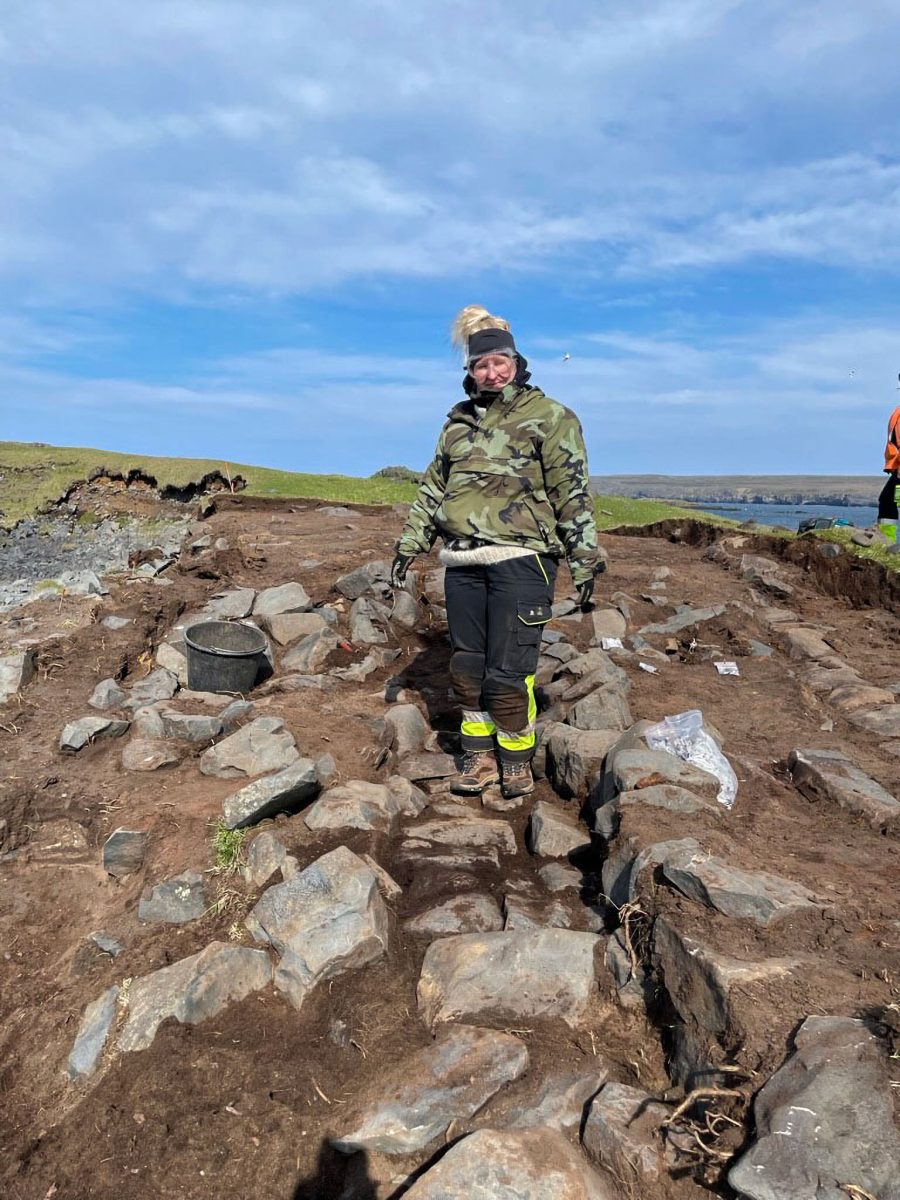
Vicki Szabo was amazed by the sheer quantity of whalebone at an archaeological site known as Hafnir. Photo courtesy of Lísabet Guðmundsdóttir
And though whales were an important source of cultural traditions, building materials, and protein in many northern cultures, most communities focused their hunting on smaller, more manageable species. Were medieval Icelanders really hunting blue whales centuries before the invention of exploding harpoons and faster steam-powered ships? If so, how were they doing it, and how often? And what can these interactions reveal about both historical and modern whale populations?
Szabo, of Western Carolina University in the United States, is now leading a multidisciplinary team of archaeologists, historians, folklorists, and geneticists to try to answer these very questions.
Szabo first became interested in Icelanders’ history with whales in the early 1990s. At first, she was limited to studying printed works like the Icelandic sagas, a collection of legendary tales recorded in the 13th and 14th centuries. The sagas and other texts—including those written by Jón Guðmundsson—are a trove of whale stories. “These people talked about whales all the time,” Szabo says. Often, they specifically mentioned blue whales.
Through her early research, Szabo learned that by the 13th century, Icelanders were so dependent on whales that they wrote complicated laws to establish how washed-up whales were divvied up. A whale’s size, how it died, and who owned the property where it beached all determined who got a share of the whale meat. Portioning also depended on who secured it to the shore; if an Icelander saw a dead whale floating in the sea, they were legally obligated to find a way to tether it to land. And hunters not only marked their spears with their signature emblem, they also registered those emblems with the government, improving the chances that they could claim their lawful share of any whale they speared. In addition to consuming whale meat and blubber, Norse people used the bones as tools, vessels, gaming pieces, furniture, and beams for roofs and walls.
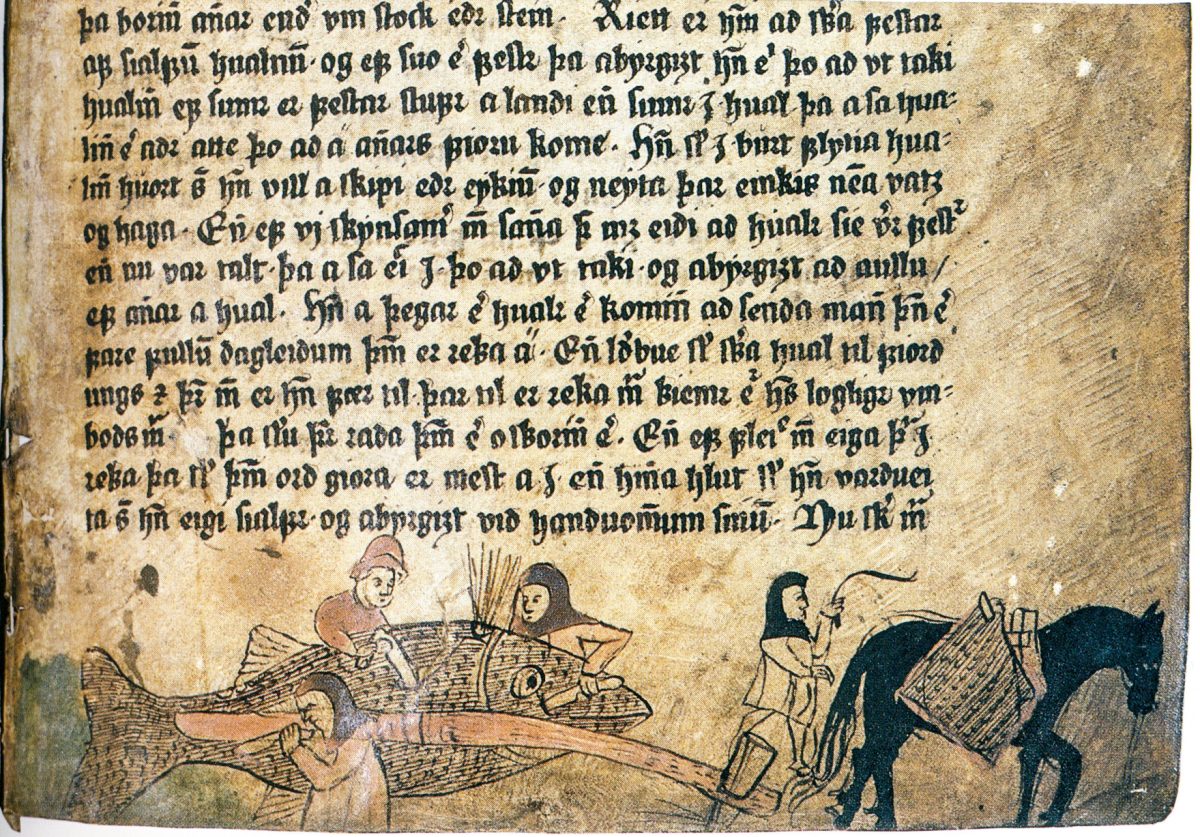
Illumination from a 16th-century Icelandic manuscript, showing people processing a rather fishlike whale. Photo courtesy of the Árni Magnússon Institute
Even with government regulations, though, whale hunting was a fraught enterprise. Spearheads were expensive, crafted by Icelandic smiths using iron smelted from deposits in bogs. One fisherman in the literature grew so frustrated at losing five spears in a single day that he gave up hunting altogether. And scavenging whales that beached themselves or turned up dead on shore still caused drama. At least five sagas tell stories of fights breaking out over the rights to stranded blue whales.
Szabo was fascinated by such stories, and curious about which whale species Icelanders relied on most. Yet it wasn’t until the mid-2000s, when scientists pioneered new techniques to analyze ancient bones using DNA analysis and spectroscopy, that Szabo could begin to answer her question. Spectroscopy, which reveals the chemical makeup of bones by analyzing collagen proteins found in bone fragments, is cheaper and faster than DNA analysis. It’s proven effective at identifying many whale species, including blues, but it can’t distinguish between certain species, such as right and bowhead whales. Scientists often use spectroscopy as an initial screen of species, then clear up any uncertainties with DNA testing.
Camilla Speller, an archaeologist at Canada’s University of British Columbia who is not involved in the Iceland project, says these technologies have helped change our knowledge of past human-whale relations, as well as our understanding of the diversity of whales that historical humans hunted. “Every time we do spectroscopy on an assemblage, I think, Oh man, I wasn’t expecting that species to appear.” When Szabo and collaborators applied DNA and spectroscopy techniques to whalebones in Iceland, the outcome was no different.
Beginning in 2017, geneticist Brenna Frasier, a collaborator of Szabo’s, analyzed the DNA of 124 whalebones from a dozen archaeological sites across Iceland dating from around 900 CE to 1800 CE in her lab at Saint Mary’s University in Nova Scotia. Over half of the bones came from blue whales. The rest were a mix of over a dozen other species. As the climate shifted from the medieval warm period, which ended in the 13th century, to the colder temperatures of the little ice age, evidence of many smaller whale species disappeared from the archaeological record. Blue whales, however, still dominated.
When Szabo saw the results, she was “staggered.” No other culture is known to have relied on blue whales so regularly. This is partially because blue whales typically live in the open ocean rather than close to shore, dive to depths of 315 meters, and tend to sink when they die. Then there’s the technical challenge of the whales’ imposing size. Frasier was involved in the necropsy of a blue whale that washed up near Halifax, Nova Scotia, in 2021. She says it took researchers several days with heavy machinery to break down the animal. “I had never been waist-deep in whale until that event,” she says.
Because of the challenges of hunting and harvesting blue whales, Szabo’s team of researchers had expected to find more evidence of smaller whales like pilot whales and minke whales, which would have been easier to drive ashore and butcher and, today at least, are more abundant. In similar archaeological and historical studies in the Faroe Islands, the relatively svelte pilot whale dominated. Medieval Dutch hunters favored right whales, which come close to shore and float when they die. Other traditional whaling cultures also tend to prefer slower or more coastal species that are more accessible and easier to hunt. “I find it surprising that a medieval whaler would go after a blue whale,” says Speller.
But as Szabo’s team continues to show, medieval Icelanders seem to have done just that.
That the DNA analysis now substantiates the attention blue whales received in Icelandic texts is gratifying for Szabo. It means that Icelanders were scavenging and likely even hunting whales as far back as the ninth century—roughly the time that they first arrived on Iceland’s shores. Authors like Guðmundsson weren’t exaggerating: Icelanders were likely encountering blues and exploiting them more than any other species of whale.
Recently, the landscape has offered further validation that preindustrial Icelanders regularly killed and harvested these leviathans. While in Iceland in 2023, Szabo and Frasier were encouraged by a colleague to meet the Icelandic archaeologist Lísabet Guðmundsdóttir from the Institute of Archaeology, Iceland. In a conference room at the University of Iceland, Guðmundsdóttir—who often studies driftwood in the archaeological record—told Frasier and Szabo of a new archaeological site, known as Hafnir, that she had been digging on the Skagi Peninsula in northwestern Iceland. As waves erode the coastline, Guðmundsdóttir said, ancient whalebones dislodge from the sediment like loose teeth, offering a new trove of research materials; Guðmundsdóttir had found whalebones left by residents at least as far back as the 12th century.
Hearing this, Frasier and Szabo shared an excited glance. While most bones were still on site, Guðmundsdóttir showed them a few she had collected. “We were just astounded by this box filled with some of the largest bones we’d ever seen from an archaeological context,” Szabo says.

The whalebones at Hafnir are so close to the water’s edge that they are eroding into the ocean. Photo courtesy of Vicki Szabo
Later, Szabo visited Hafnir herself. Hafnir’s fertile bays and long green grass give the appearance of a place that would be ideal for settlement if the weather wasn’t so often terrible. Local farmers recently told Guðmundsdóttir that last spring’s winds were so strong they picked up lambs and blew them downwind. Later that summer, Guðmundsdóttir lost a tent on the dig site in the same way. “The wind and the rain can drive you insane,” she admits.
For the researchers, the struggles are worth it. “I’ve never seen an archaeological site with this much whalebone falling out,” Szabo says. There are too many whalebones for it to be random beached whales, Guðmundsdóttir adds: “[People] must have been hunting them.” So far, the team has uncovered dozens, possibly hundreds, of whalebones that were worked or whittled by local people across many phases of settlement. They’ve also found unprecedented intact bones, like a vertebra the diameter of a steering wheel, that are so big Szabo thinks they must have come from blue whales. The researchers are now in the process of running their initial spectroscopy tests to confirm that blue whales are as common here as they’ve proven to be at other Icelandic sites.
But they need to act fast: every time the archaeological team returns, more history has been lost to the sea. “It is the last chance to get the information out before it just completely goes,” Guðmundsdóttir says.
For Szabo’s project, which is set to wrap up in the fall of 2024, one question remains: how exactly were Icelanders able to harvest so many blue whales? Ævar Petersen, an independent Icelandic biologist and consultant for Szabo’s project, suspects people may have hunted the smaller calves of the species, which can be more curious toward humans and more manageable once dead. He also thinks that early settlers wouldn’t have cared what species of whale they’d found; they’d use whatever was readily available. Perhaps what was most available was blue whales.
This theory is backed up by new evidence that blue whales may have been more abundant and lived closer to shore between 900 and 1900 CE than today. As Petersen recently documented, for example, 32 blue whales were trapped in an ice-filled cove in Ánastaðir in northwestern Iceland during a raging May snowstorm in 1882—an exceptionally cold year in Iceland when famine loomed. There were no roads, yet people flocked to the cove, traveling over the icy landscape on foot or horseback—some from as far as 100 kilometers away—to help kill and butcher the whales. Whale meat from Ánastaðir possibly saved several thousand people from starvation. Some meat and blubber were eaten fresh; some were stored in special pits called hvalgrafir for as long as four years.
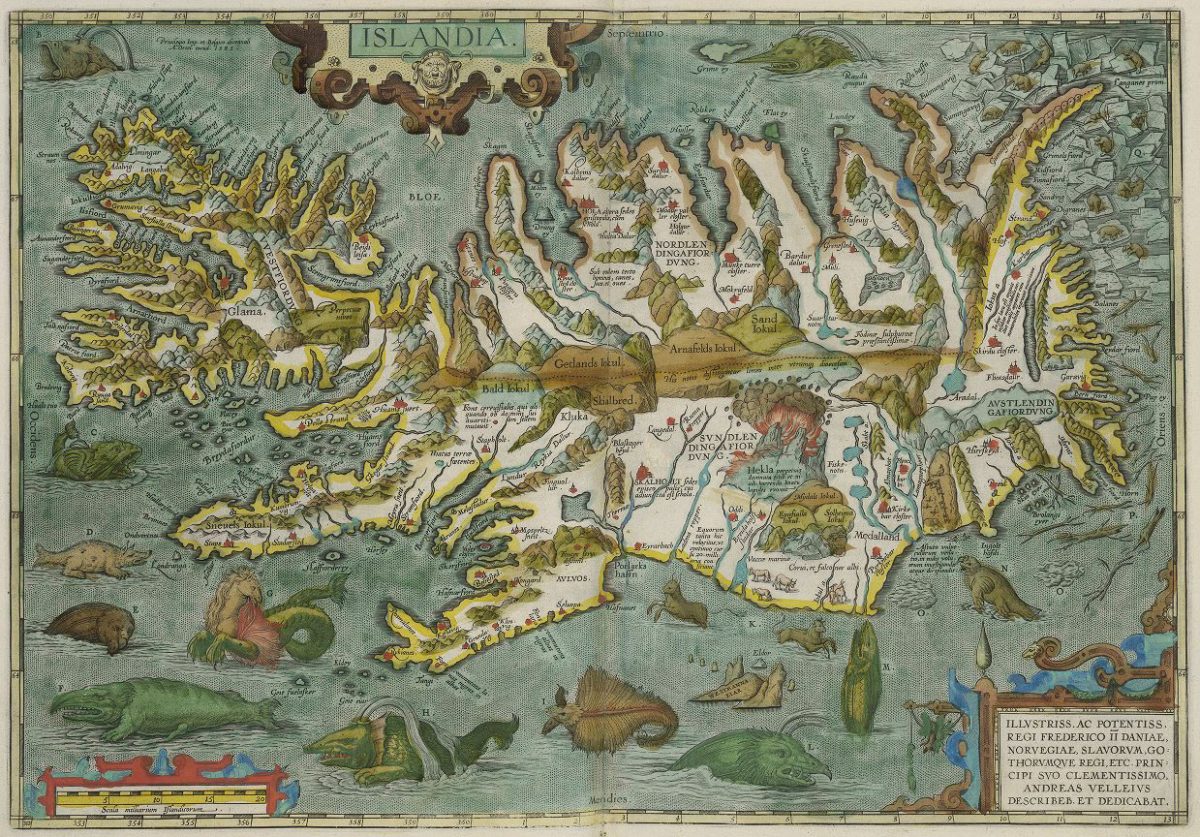
A 17th-century map of Iceland, complete with fantastical sea creatures, by Abraham Ortelius. Photo public domain
Today, finding so many blue whales so close to shore is unheard of.
A year after the 1882 slaughter at Ánastaðir, improved technology allowed Norwegians to begin hunting blue whales at an industrial scale around Iceland. Other nations soon followed, and by the mid-20th century, industrial whalers from the United States, Japan, Russia, and elsewhere had likely massacred 90 percent of the planet’s blue whale population. Even though Iceland no longer allows blue whale hunting, commercial whaling is still legal there today. Iceland is the only country that allows whaling of the endangered fin whale, the second-largest whale species.
Around the same time as the 1882 slaughter, a slight global cooling trend brought more ice into Iceland’s coves. The combination of human pressures and an icier coast may have eventually driven blue whales offshore. Perhaps, Szabo theorizes, Icelanders were able to harvest so many blue whales because they behaved differently than today’s blue whales: industrial whaling hadn’t yet decimated their population, and different climatic conditions tempted them closer to shores and coves. Northwestern Iceland in particular—where Hafnir, Ánastaðir, and several other archaeological sites are located—increasingly stands out as a historical hotspot of blue whale activity.
Northwestern Iceland is also where Ólafur, the 14th-century hunter, speared blue whales from his open wooden boat. Later in his life, Ólafur saw a female whale coming into the bay near his home. According to Guðmundsson’s telling, Ólafur took aim but only punctured the animal’s dorsal fin. The scarred blue whale returned to the same bay for 15 years afterward. Ólafur appears to have developed a personal kinship with the whale, choosing not to try to kill her again. But he had no problem shooting the whale’s calf. One summer, when he raised his spear and took aim at the calf, his spear went askew, hitting the mother instead.
With that, he’d had enough. That was the last time Ólafur speared a whale.

